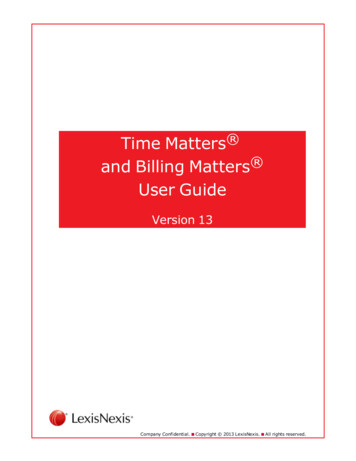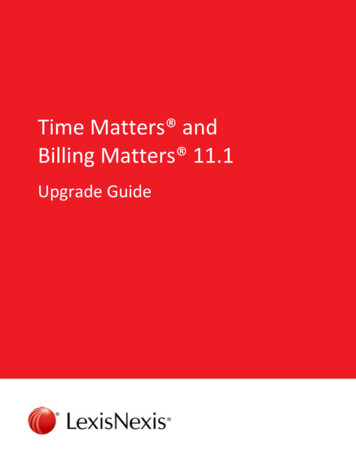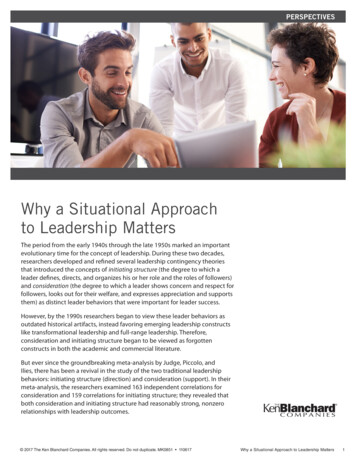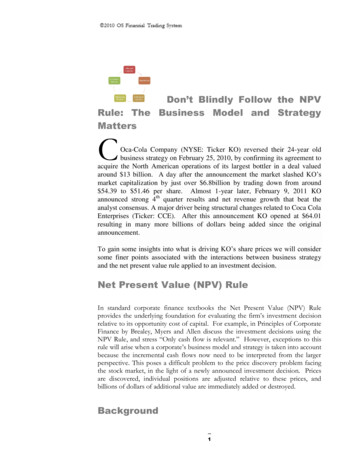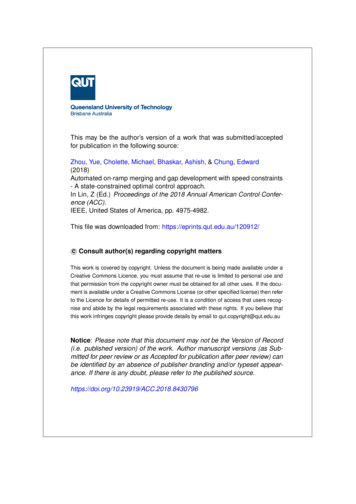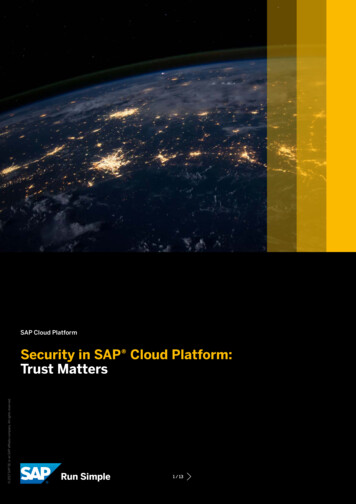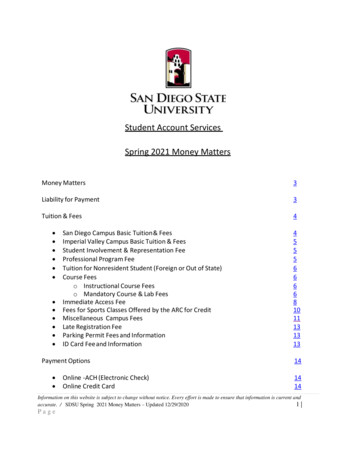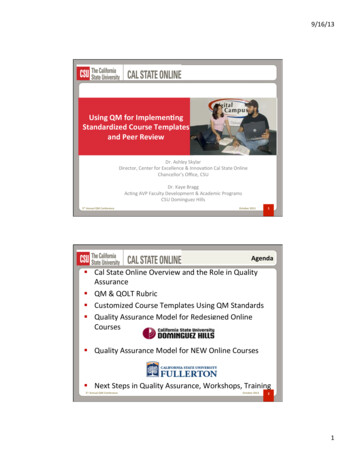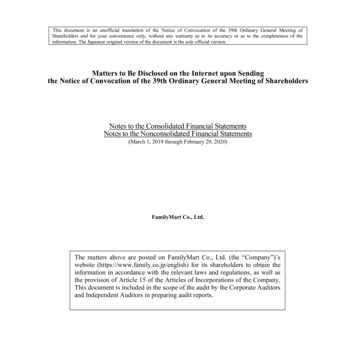
Transcription
This document is an unofficial translation of the Notice of Convocation of the 39th Ordinary General Meeting ofShareholders and for your convenience only, without any warranty as to its accuracy or as to the completeness of theinformation. The Japanese original version of the document is the sole official version.Matters to Be Disclosed on the Internet upon Sendingthe Notice of Convocation of the 39th Ordinary General Meeting of ShareholdersNotes to the Consolidated Financial StatementsNotes to the Nonconsolidated Financial Statements(March 1, 2019 through February 29, 2020)FamilyMart Co., Ltd.The matters above are posted on FamilyMart Co., Ltd. (the “Company”)’swebsite (https://www.family.co.jp/english) for its shareholders to obtain theinformation in accordance with the relevant laws and regulations, as well asthe provision of Article 15 of the Articles of Incorporations of the Company.This document is included in the scope of the audit by the Corporate Auditorsand Independent Auditors in preparing audit reports.
[Notes to the Consolidated Financial Statements]The Basis of Presentation of the Consolidated Financial Statements1. Standards Applied for Preparation of the Consolidated Financial StatementsThe consolidated financial statements of the Company and its subsidiaries (together, the “Group”) are prepared in accordance withInternational Financial Reporting Standards (“IFRSs”), pursuant to the provisions of the first paragraph of Article 120 of the Ordinanceon Company Accounting. Certain disclosure items required by IFRSs are omitted pursuant to the provisions of the second sentence ofsaid paragraph.2. Scope of ConsolidationNumber of subsidiaries: 24 companiesMajor subsidiaries: Taiwan FamilyMart Co., Ltd.; famima Retail Service Co., Ltd.; Famima Digital One Co., Ltd.; SENIOR LIFECREATE Co., Ltd., and EVENTIFY INC.FamilyMart Co., Ltd. was removed from the scope of consolidation in the fiscal year ended February 29, 2020, following the Company’sabsorption-type merger of its wholly-owned subsidiary, FamilyMart Co., Ltd.Kanemi Co., Ltd. and one other company were removed from the scope of consolidation in the fiscal year ended February 29, 2020,following the reclassification of Kanemi Co., Ltd. from a subsidiary to an associate due to a partial transfer of its shares held by theCompany.3. Application of the Equity MethodNumber of associates and joint ventures: 20 companiesMajor associates and joint ventures: Okinawa FamilyMart Co., Ltd.; Minami Kyushu FamilyMart Co., Ltd.; Central FamilyMart Co.,Ltd.; Shanghai FamilyMart Co., Ltd.; Guangzhou FamilyMart Co., Ltd.; Suzhou FamilyMart Co., Ltd.; POCKET CARD CO., LTD.;LIVE VIEWING JAPAN Inc.; and Kanemi Co., Ltd.In the fiscal year ended February 29, 2020, Kanemi Co., Ltd. is to be accounted for by the equity method, following the reclassificationof Kanemi Co., Ltd. from a subsidiary to an associate due to a partial transfer of its shares held by the Company.4. Accounting Policies(1) Basis of consolidation1) SubsidiariesSubsidiaries are entities which are controlled directly or indirectly by the Company. In judging whether an entity is controlled directlyor indirectly by the Company, the Company takes into consideration various factors indicating the possibility of control. Such factorsinclude the existence of voting rights and potential voting rights which the Company can exercise in a substantial way, or whether themajority of the director positions are occupied by the officers and employees dispatched by the Company and its subsidiaries.Considering the above, the Company decides whether it has the exposure or the right to the variable returns from the involvement of theCompany with the entity, and whether it has the ability to use its power over the entity to affect the amount of the Company’s returnsthrough power over the entity.The financial statements of the subsidiaries are included in the scope of consolidation from the date on which the Group obtains controlof a subsidiary and to the date on which the Group loses control of the subsidiary.When the accounting policies of a subsidiary are different from those of the Group, adjustments are reflected, as needed, in the financialstatements of the subsidiary. Intragroup balances and transactions and unrealized gains and losses which have resulted from intragrouptransactions are eliminated in the presentation of the consolidated financial statements.Disposals of a part of equity interests in a subsidiary are accounted for as capital transactions if the Company does not lose control overthe subsidiary. The difference between the adjustment of the non-controlling interests and fair value of the consideration is recognizeddirectly in equity as equity interests attributable to owners of the parent.―1―
When the Company loses control of a subsidiary, the gains or losses associated with the loss of control of the subsidiary are recognizedin profit or loss.2) AssociatesAssociates are entities over which the Group has significant influence. In determining whether the Group has significant influence overan entity or not, the Company takes into consideration various factors. Such factors include the existence of voting rights and potentialvoting rights which the Company can exercise in a substantial way and the proportion of officers on the board of directors that havebeen dispatched by the Company and its subsidiaries.Investments in associates are recognized at cost at the time of acquisition and are accounted for using the equity method. The carryingamount of investments in associates includes goodwill, which is recognized at the time of the acquisition, net of accumulatedimpairment losses.When the accounting policies of an associate are different from those of the Group, adjustments are reflected, as needed, in the financialstatements of the associate.3) Joint arrangementsJoint arrangements are referred to as contractual arrangements over which two or more parties have joint control. The Group classifiesits involvement in joint arrangements, depending on the rights and obligations of the parties involved in the arrangements, into: jointoperations, where the Group has rights to the assets and obligations to the liabilities relating to the arrangements; and joint ventures,where the Group has only rights to the net assets relating to the arrangements. With regard to joint operations over which the Group hasjoint control, the assets, liabilities, revenues, and expenses attributable to the Group’s equity interests are recognized, while investmentsin joint ventures are accounted for using the equity method.(2) Business combinationsBusiness combinations, except for the transactions among entities under common control, are accounted for by the acquisition method.Consideration for a business combination is measured at fair value, which is calculated as the sum of the acquisition-date fair values ofthe assets transferred by the acquirer, net of liabilities assumed by the acquirer to the former owners of the acquiree, and equity interestsissued by the acquirer. When the sum of consideration transferred, any non-controlling interest in the acquiree, and the acquisition-datefair value of the acquirer’s previously held equity interest in the acquiree exceeds the net acquisition-date amount of the identifiableassets acquired and the liabilities assumed, the excess is recorded as goodwill in the consolidated statement of financial position.Conversely, when the net acquisition-date amount of the identifiable assets acquired and liabilities assumed exceeds the sum of theconsideration transferred, any non-controlling interest in the acquiree, and the acquisition-date fair value of the acquirer’s previously heldequity interest in the acquiree, the excess is recognized immediately in profit.Costs incurred by the acquirer in relation to a business combination, including brokerage, attorney’s fees, and due diligence expenses, areexpensed in the period in which these costs are incurred.When the initial accounting for a business combination is incomplete by the end of the reporting period in which the businesscombination occurs, the Group reports provisional amounts for the items for which the accounting is incomplete. Those provisionalamounts are retrospectively adjusted during the period after the acquisition date during which the acquirer may adjust the provisionalamounts recognized for a business combination (the “measurement period”) to reflect new information obtained about facts andcircumstances that existed at the acquisition date that, if known, would have affected the amounts recognized at that date. During themeasurement period, the acquirer also recognizes additional assets or liabilities if new information is obtained that would have resulted inthe recognition of those assets and liabilities. The measurement period is at most one year from the acquisition date.It is also noted that the additional acquisition of non-controlling interests after the acquisition of control is accounted for as a capitaltransaction, where no goodwill is recognized.The identifiable assets acquired and the liabilities assumed by the acquirer are recognized at their fair value at the acquisition date, exceptthat:- Deferred tax assets or liabilities are recognized and measured in accordance with International Accounting Standards IAS 12,―2―
“Income Taxes.”- Assets or liabilities related to employee benefit arrangements are recognized and measured in accordance with IAS 19, “EmployeeBenefits.”- Liabilities related to share-based payment arrangements of the acquiree are measured in accordance with IFRS 2, “Share-basedPayment.”- Assets (or disposal groups) that are classified as held for sale in accordance with IFRS 5, “Non-current Assets Held for Sale andDiscontinued Operations,” are measured in accordance with that standard.A business combination involving entities or businesses under common control is a business combination in which all of the combiningentities or businesses are ultimately controlled by the same party or parties both before and after the business combination, and thatcontrol is not transitory. All business combination transactions among entities under common control are accounted for based on thecarrying amounts on a continuous basis.(3) Foreign currency translation1) Foreign currency transactionsForeign currency transactions are translated into the functional currency of each entity within the Group at the exchange rate on thetransaction date.Foreign currency monetary assets and liabilities at the end of the reporting period are translated into the functional currency using theexchange rate at the end of the reporting period.Non-monetary assets and liabilities which are measured at fair value in a foreign currency are translated into the functional currencyusing the exchange rate at the date on which the fair value was measured.Exchange differences arising on translation or settlement of monetary items are recognized in profit or loss. Exchange differencesarising on financial assets measured through other comprehensive income and cash flow hedges are recognized in other comprehensiveincome.2) Financial statements of foreign operationsAssets and liabilities of foreign operations are translated into Japanese yen using the exchange rate at the end of the reporting period,while revenues and expenses of the foreign operations are translated into Japanese yen using the average exchange rate for the period,unless there have been significant changes in exchange rates. Exchange differences arising from the translation of financial statementsof the foreign operations have been recognized in other comprehensive income. The cumulative amount of the exchange differencesrelated to foreign operations is recognized in profit or loss in the period in which the foreign operations are disposed of.(4) Financial instruments1) Financial assets(i) Initial recognition and measurementFinancial assets are initially recognized when the Group becomes a party to a contract and are classified into financial assetsmeasured at fair value through profit or loss, through other comprehensive income, or those measured at amortized cost.All financial assets, other than those measured at fair value through profit or loss, are initially measured at fair value plustransaction costs that are directly attributable to the financial asset.Financial assets that meet both of the following conditions are classified as financial assets measured at amortized cost.- The financial asset is held to collect contractual cash flows; and,- The contractual terms of the financial asset give rise on specified dates to cash flows that are solely payments of principal andinterest on the principal amount outstanding.Financial assets other than those measured at amortized cost are classified as financial assets measured at fair value.―3―
Equity instruments measured at fair value, except for equity instruments held for trading that are required to be measured at fairvalue through profit or loss, are designated either as measured at fair value through profit or loss, or as measured at fair valuethrough other comprehensive income for each equity instrument, and such designation applies on an ongoing basis.Debt instruments measured at fair value that meet both of the following conditions are classified as financial assets measured at fairvalue through other comprehensive income and all other debt instruments are classified into financial assets measured at fair valuethrough profit or loss.- The financial asset is held within a business model whose objective is achieved by both collecting contractual cash flows andselling financial assets; and- The contractual terms of the financial asset give rise on specified dates to cash flows that are solely payments of principal andinterest on the principal amount outstanding.(ii) Subsequent measurementAfter initial recognition, financial assets are measured according
In the fiscal year ended February 29, 2020, Kanemi Co., Ltd. is to be accounted for by the equity method, following the reclassification of Kanemi Co., Ltd. from a subsidiary to an associate due to a partial transfer of its shares held by the Company. 4. Accounting Policies (1) Basis of consolidation 1) Subsidiaries Subsidiaries are entities which are controlled directly or indirectly by the .
